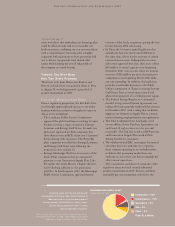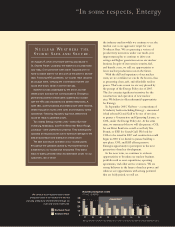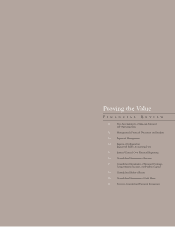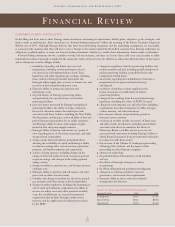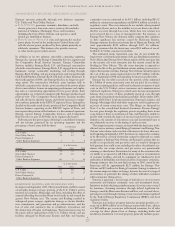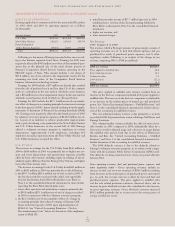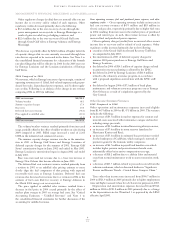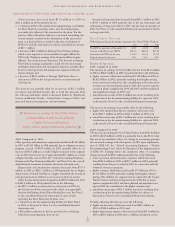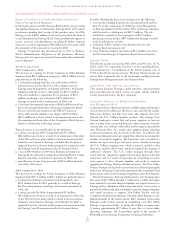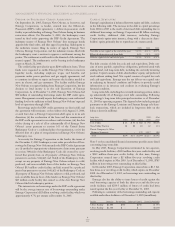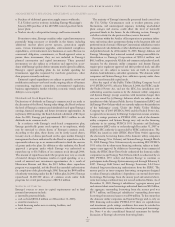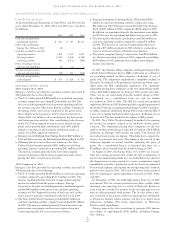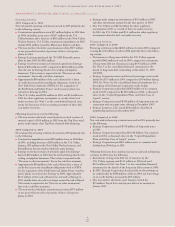Entergy 2005 Annual Report Download - page 36
Download and view the complete annual report
Please find page 36 of the 2005 Entergy annual report below. You can navigate through the pages in the report by either clicking on the pages listed below, or by using the keyword search tool below to find specific information within the annual report.
ENTERGY CORPORATION AND SUBSIDIARIES 2005
*
32
Entergy operates primarily through two business segments:
U.S. Utility and Non-Utility Nuclear.
■U.S. UTILITY generates, transmits, distributes, and sells
electric power in a four-state service territory that includes
portions of Arkansas, Mississippi, Texas, and Louisiana,
including the City of New Orleans; and operates a small
natural gas distribution business.
■NON-UTILITY NUCLEAR owns and operates five nuclear
power plants located in the northeastern United States and
sells the electric power produced by those plants primarily to
wholesale customers. This business also provides services
to other nuclear power plant owners.
In addition to its two primary, reportable, operating segments,
Entergy also operates the Energy Commodity Services segment and
the Competitive Retail Services business. Energy Commodity
Services includes Entergy-Koch, L.P. and Entergy’s non-nuclear
wholesale assets business. Entergy-Koch, L.P. engaged in two major
businesses: energy commodity marketing and trading through
Entergy-Koch Trading, and gas transportation and storage through
Gulf South Pipeline. Entergy-Koch sold both of these businesses in
the fourth quarter of 2004, and Entergy-Koch is no longer an oper-
ating entity. The non-nuclear wholesale assets business sells to
wholesale customers the electric power produced by power plants
that it owns while it focuses on improving performance and explor-
ing sales or restructuring opportunities for its power plants. Such
opportunities are evaluated consistent with Entergy’s market-based
point-of-view. The Competitive Retail Services business markets
and sells electricity, thermal energy, and related services in compet-
itive markets, primarily in the ERCOT region in Texas. Entergy has
decided to divest the retail electric portion of the Competitive Retail
Services business operating in the ERCOT region of Texas, and
now reports this portion of the business as a discontinued operation.
Entergy reports Energy Commodity Services and Competitive
Retail Services as part of All Other in its segment disclosures.
Following are the percentages of Entergy’s consolidated revenues
and net income generated by its operating segments and the
percentage of total assets held by them: % of Revenue
Segment 2005 2004 2003
U.S. Utility 84 81 82
Non-Utility Nuclear 14 13 14
Parent Company &
Other Business Segments 2 6 4
% of Net Income
Segment 2005 2004 2003
U.S. Utility 74 72 52
Non-Utility Nuclear 30 26 32
Parent Company &
Other Business Segments (4) 2 16
% of Total Assets
Segment 2005 2004 2003
U.S. Utility 82 80 79
Non-Utility Nuclear 16 16 15
Parent Company &
Other Business Segments 2 4 6
HURRICANE KATRINA AND HURRICANE RITA
In August and September 2005, Hurricanes Katrina and Rita caused
catastrophic damage to large portions of the U.S. Utility’s service
territory in Louisiana, Mississippi, and Texas, including the effect of
extensive flooding that resulted from levee breaks in and around the
greater New Orleans area. The storms and flooding resulted in
widespread power outages, significant damage to electric distribu-
tion, transmission, and generation and gas infrastructure, and the
loss of sales and customers due to mandatory evacuations and
the destruction of homes and businesses. Total restoration costs for
the repair and/or replacement of the U.S. Utility’s electric and gas
facilities damaged by Hurricanes Katrina and Rita and business
continuity costs are estimated to be $1.5 billion, including $835.2
million in construction expenditures and $664.8 million recorded as
regulatory assets. The cost estimates do not include other potential
incremental losses, such as the inability to recover fixed costs sched-
uled for recovery through base rates, which base rate revenue was
not recovered due to a loss of anticipated sales. For instance, at
Entergy New Orleans, the domestic utility company that continues
to have significant lost revenue caused by Hurricane Katrina,
Entergy estimates that lost net revenue due to Hurricane Katrina will
total approximately $320 million through 2007. In addition,
Entergy estimates that the hurricanes caused $32 million of uncol-
lectible U.S. Utility customer receivables.
The estimated storm restoration costs also do not include the
longer-term accelerated replacement of the gas distribution system in
New Orleans that Entergy New Orleans expects will be necessary due
to the massive salt water intrusion into the system caused by the
flooding in New Orleans. The salt water intrusion is expected to
shorten the life of the gas distribution system, making it necessary to
replace that system over time. Entergy New Orleans currently expects
the cost of the gas system replacement to be $355 million, with the
project beginning in 2008 and extending for many years thereafter.
Entergy has recorded accruals for the portion of the estimated
$1.5 billion of storm restoration costs not yet paid. In accordance
with its accounting policies, and based on historic treatment of such
costs in the U.S. Utility’s service territories and communications
with local regulators, Entergy recorded assets because management
believes that recovery of these prudently incurred costs through
some form of regulatory mechanism is probable. In December 2005,
Entergy Gulf States’ Louisiana jurisdiction, Entergy Louisiana, and
Entergy Mississippi filed with their respective retail regulators for
recovery of storm restoration costs. The filings are discussed in
Note 2 to the consolidated financial statements. Because Entergy
has not gone through the regulatory process regarding these storm
costs, however, there is an element of risk, and Entergy is unable to
predict with certainty the degree of success it may have in its recovery
initiatives, the amount of restoration costs and incremental losses it
may ultimately recover, or the timing of such recovery.
The temporary power outages associated with the hurricanes in the
affected service territory caused Entergy Louisiana’s and Entergy New
Orleans’ sales volume and receivable collections to be lower than nor-
mal beginning in September 2005. Revenues are expected to continue
to be affected for a period of time that cannot be estimated as a result
of customers at Entergy New Orleans and Entergy Louisiana that are
unable to accept electric and gas service and as a result of changes in
load patterns that could occur, including the effect of residential cus-
tomers who can accept electric and gas service not permanently
returning to their homes. Restoration for many of the customers who
are unable to accept service will follow major repairs or reconstruction
of customer facilities, and will be contingent on validation by local
authorities of habitability and electrical safety of customers’ structures.
Entergy estimates that lost non-fuel revenues in 2006 caused by the
hurricanes will be approximately $123 million for Entergy New
Orleans and $39 million for Entergy Louisiana. Entergy’s estimate of
the revenue impact is subject to change, however, because of a range of
uncertainties, in particular the timing of when individual customers
will recommence taking service.
Entergy is pursuing a broad range of initiatives to recover storm
restoration and business continuity costs and incremental losses.
Initiatives include obtaining reimbursement of certain costs covered
by insurance, obtaining assistance through federal legislation for
damage caused by Hurricanes Katrina and Rita, and, as noted above,
pursuing recovery through existing or new rate mechanisms regulated
by the Federal Energy Regulatory Commission (FERC) and local
regulatory bodies.
Entergy’s non-nuclear property insurance program provides cov-
erage up to $400 million on an Entergy system-wide basis, subject
to a $20 million per occurrence self-insured retention, for all risks
coverage for direct physical loss or damage, including boiler and
machinery breakdown. Covered property generally includes power
MANAGEMENT’S FINANCIAL DISCUSSION and ANALYSIS




